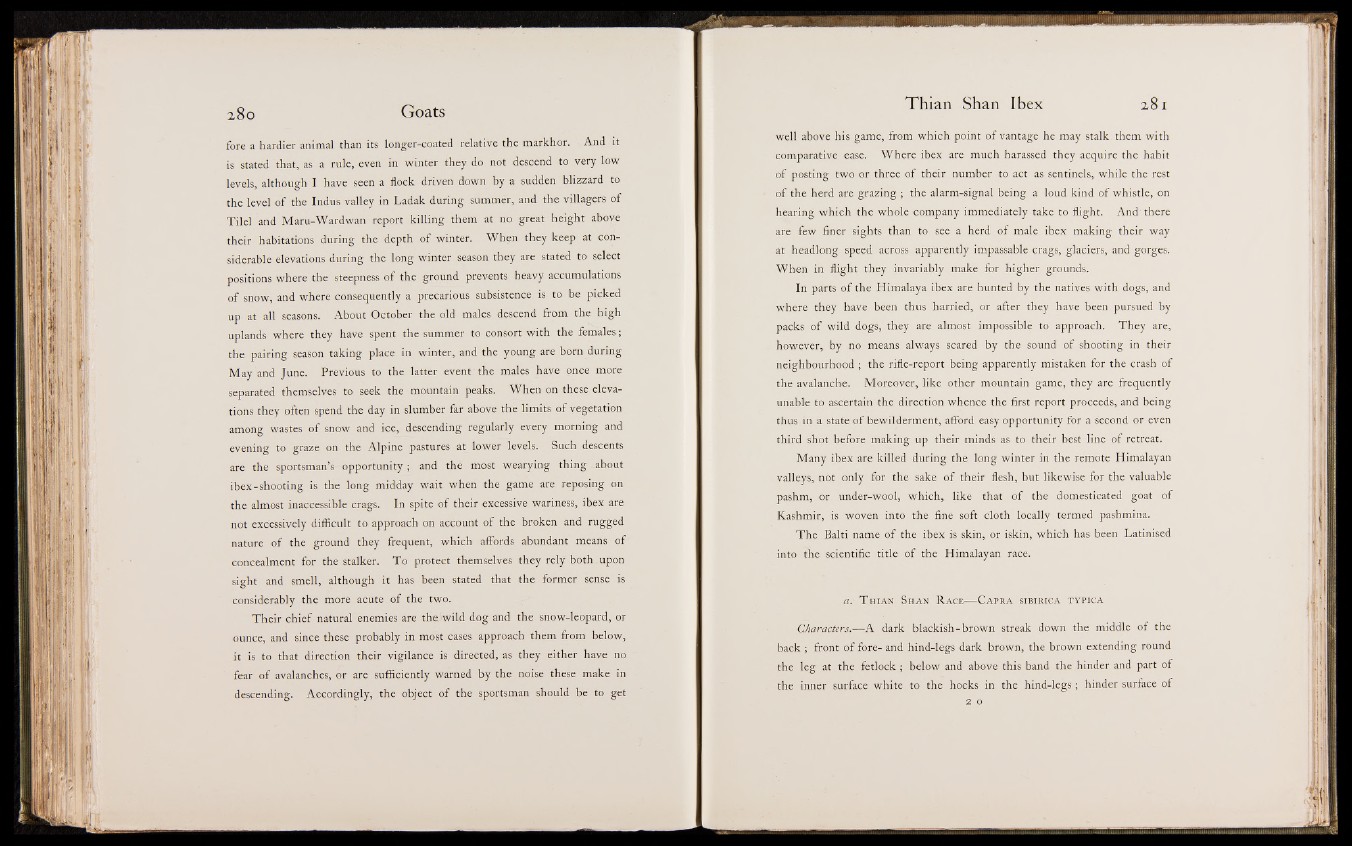
fore a hardier animal than its longer-coated relative the markhor. And it
is stated that, as a rule, even in winter they do not descend to very low
levels, although I have seen a flock driven down by a sudden blizzard to
the level of the Indus valley in Ladak during summer, and the villagers of
Tilel and Maru-Wardwan report killing them at no great height above
their habitations during the depth of winter. When they keep at considerable
elevations during the long winter .season they are stated tpjsetect
positions where the steepness of the ground prevents heavy accumulations
of snow, and where consequently a precarious subsistence is to be picked
up at all seasons. About October the old males descend from the high
uplands where they have spent the summer to consort with the females;
the pairing season taking place in winter, and the young are born during
May and June. Previous to the latter event the males have once more
separated themselves to seek the mountain peaks. When on these elevations
they often spend the day in slumber far above the limits of vegetation
among wastes of snow and ice, descending regularly every morning and
evening to graze on the Alpine pastures at lower levels. Such descents
are the sportsman%iopportunity ; and the most wearying thing .about
ibex-shooting is the long midday wait when the game are reposing on
the almost inaccessible crags. In spite of their excessive warinesj^ibex are
not excessively difficult to approach on account of the broken and rugged
nature of the ground they frequentfiwhich affords abundant meanfBof
concealment for the stalker. To protect themselves they rely both upon
sight and smell, although it has been stated that the former sense is 1
Considerably the more acute , of the two.
Their chief natural enemies are thejwild dog and the snow-leopard, or
ounce, and since these probably in most cases approach them from below,
it is to that direction their vigilance is directed, as they either have no
fear of avalanches, or are sufficiently warned by the noise these make in
descending. Accordingly, the object of the sportsman should be to get
Thian Shan Ibex 281
well above his game, from which point of vantage he may-stalk them with
comparative ease. Where ibex are much harassed they acquire the habit
of posting two or three of their number to act as sentinels, while the rest
of the herd are grazing ; the alarm-signal being a loud kind of whistle, on
hearing which the whole company immediately take to flight. And there
are £ $$ finer eights than tfijsfie a herd of. male ibex making their way
at headlong speed acgtM apparently impassable crags, glaciers, and gorges.
When in flight they invariably make for higher grounds.
In parts of the Himalaya ibex are hunted by the natives with dogs, and
where they have been thus harried, or after they have been pursued by
packsjpff wild dogs, they are almost impossible to approach. They are,
however, by no means alwaySscared by tb e S u n d of shooting in their
neighbourhood ; the rifle-report being apparently mistaken for the crash of
the avalanche. Moreover, like B h e r mountain game, they are ’frequently
unable fq ascertain the direction whence the first report proceeds, and being
thus in a state of bewilderment, afford easy opportunity for a. second or even
third jjjot before making up their minds B to their best line of retreat.
Many ibex aire killed during th e apig winter in thMj-emote Himalayan
valleys, not only j| r the sake of their flesh, but likewise for the valuable
pashm, or under-wool, which, like that o f the domesticated goat of
Kashmir, is woven into the fine soft cloth locally termed pashmina.
The Balti name of the ibex Is skin, m iskin, which has been Latinised
into the scientific title of the Himalayan race.
a. T h ian S han R a c e—-Ca p r a s ib ir ic a t y p ic a
C/iaracter^g-A dark blackish -thrown streak down the middle of the
back ; front of fore- and hind-legs dark brown, the brown extending round
the leg at the fetlock ; below and above this band the hinder and part of
the inner surface white to the hocks in the hind-legs; hinder surface of
2 ES